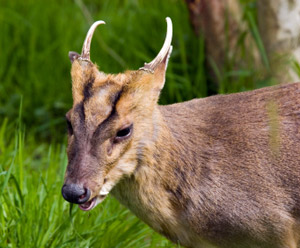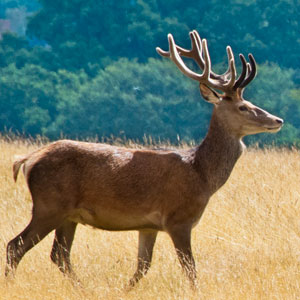Why do we need to shoot deer in British woodlands?

Today there are more deer in the UK than at any time since the last Ice Age. They no longer have any natural predators in woodlands or fields. Total deer numbers are conservatively estimated at about 1.5 million and the rapidly expanding deer population threatens woodland biodiversity. Over-grazing and browsing, particularly in ancient woodland, continues to have two very unfortunate consequences for conservation. First, it can lead to a decline and loss in plant species in a given area, which often includes oxlip and bluebells. Deer frequently damage saplings and cause other damage by stripping bark with their antlers. Secondly, as ecologist Dr Paul Dolman says: ‘There is evidence that deer reduce the number of woodland birds - especially some of our much loved migrant birds species like Blackcap and Nightingale, and resident species like Willow Tit’. As well as restricting woodland biodiversity, overgrazing and overpopulation can lead to food shortages for deer and consequently a malnourished and unhealthy deer population.
 Deer not only cause problems for maintaining the ecosystems in small woodlands, but can also cause problems for farmers who are acutely aware of the explosion in deer numbers. Deer cause damage to crops by browsing, grazing and trampling fields, and they can also transmit disease to livestock. These diseases might include blue tongue, bovine tuberculosis and foot and mouth disease. However, the Veterinary Laboratories Agency reports that the extent to which is the case is unknown due to limited research and funding. Road traffic accidents are increasing in line with rising deer populations, particularly in South East England. Unsurprisingly, these accidents generally occur on roads running through woodlands with particularly high deer densities and often involve cars travelling at high speeds at night.
Deer not only cause problems for maintaining the ecosystems in small woodlands, but can also cause problems for farmers who are acutely aware of the explosion in deer numbers. Deer cause damage to crops by browsing, grazing and trampling fields, and they can also transmit disease to livestock. These diseases might include blue tongue, bovine tuberculosis and foot and mouth disease. However, the Veterinary Laboratories Agency reports that the extent to which is the case is unknown due to limited research and funding. Road traffic accidents are increasing in line with rising deer populations, particularly in South East England. Unsurprisingly, these accidents generally occur on roads running through woodlands with particularly high deer densities and often involve cars travelling at high speeds at night.
A healthy herd is one of the top priorities for responsible deer stalkers. When planning cull figures, full-time deer managers of large woodlands sometimes take into account a range of other objectives, such as trophy hunting and venison production. However, for small woodland owners a simple way a healthy herd can be maintained is by making sure the ratio of ages and sexes are kept in balance.
The problems deer pose to woodland biodiversity are unlikely to go away, and are likely to get worse unless bold measures are taken. These problems are not helped in the UK by the expansion in broad-leaved woodlands, which are less resilient to deer impacts than conifer woodland. As the woodland expert, Oliver Rackham says, “Deer are not fools. They know that a plastic tree guard means dinner inside”. Moreover, effective deer fencing has proved difficult and expensive to implement successfully.
Recent evidence suggests that a cull of at least 50% of the UK deer population will be needed to stop the deer from creating permanent damage to our woodlands.
Comments are closed for this post.
Discussion
Nick,
If you need to reduce numbers then you need to know what the population and annual recruitment(ie new deer) is each year. your cull needs to exceed this. So you do need to cull the does quite heavily (in the correct season) However you must also cull the bucks as well to keep a balance. With fallow and red deer one buck or stag will tend to dominate the herd. Whereas Roe and Muntjac do not herd and tend to be solitary or small family groups.
I am not expert in deer or woodlands but I do read a lot. A book which caught my eye was Colin Elford’s A YEAR IN THE WOODS (ISBN: 978-0-141-04318-0). Highly readable!
So: “a simple way a healthy herd can be maintained is by making sure the ratio of ages and sexes are kept in balance.” Only it isn’t simple at all. My own efforts to keep Fallow numbers from growing each year (with resultant unsustainable pressure on the woodland) have been directed mainly towards culling does. It’s beginning to work. Am I getting it all wrong? What is that “balance” supposed to look like?
Owners should get together and decide a deer management plan.
It will vary depending on which part of the country you are situated.
A cull of 50% is draconian unless you are in a particulay bad area
normally 30% is more appropriate.
A healthy deer population is a natural benefit and we all like
to see these beuatiful animals in the woods. A small amount of deer damage
is acceptable. However in some areas new plantings and coppicing schemes can
be devastated.
Allowing deer numbers to go unchecked will result in damage to trees and other flora.
Road Traffic Accidents will increase. Undesirable poachers will start visiting
your woodland. Ensure that the person you deligate to control deer is suitably trained and a qualified hunter.
Tend to agree with Ashley……although still wary about large predators anywhere in UK!?
Re-introducing predators in England would be tricky (bear, wolf, lynx) so culling is surly an answer. Surely there would be a market for the venison? In Scotland there is a case for re-introducing lynx as there are much bigger areas of forest.

You might find that introducing Lynx to control deer wouldn’t work as sheep are much easier prey. The hill sheep farmers have a bad enough time with foxes picking off lambs without introducing something big enough to attack adult sheep. The lynx are not just going to stay in the forest.
Yvonne
2 November, 2015